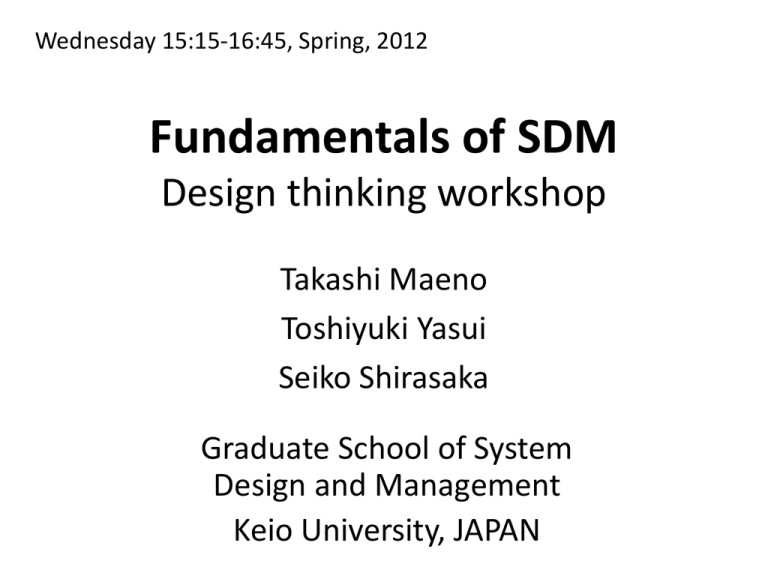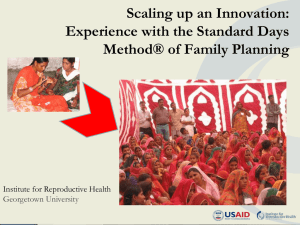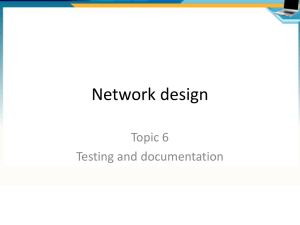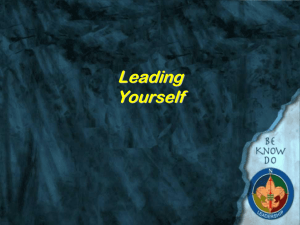Powerpoint file - Keio University
advertisement

Wednesday 15:15-16:45, Spring, 2012 Fundamentals of SDM Design thinking workshop Takashi Maeno Toshiyuki Yasui Seiko Shirasaka Graduate School of System Design and Management Keio University, JAPAN Schedule 1. 2. 3. 4. 5. 6. 7. 8. 9. 10. 11. 12. 4/11 Whole view of innovative system design (Maeno) 4/25 Team building (Shirasaka) 5/2 Brain Storming (Maeno) APCOSE (Yasui & Shirasaka absent) 5/9 System thinking (Yasui) 5/16 Observation (Maeno) 5/23 Value Graph (Yasui) 5/30 Scenario Graph (Shirasaka) 6/6 Special lecture of English paper writing (Melinda Hull) (16:45-18:45) 6/13 CVCA/WCA (Maeno) 6/27 Pugh concept selection (Yasui) 7/4 Prototyping for empathy and test (Shirasaka) 7/18 Final Presentation Today’s outline • Who am I? • Who are we? (Self introduction and practice of presenting) – GCOE Ras, SDM students (Master and Ph.D course) • • • • What is SDM? What is SYSTEM THINKING? What is DESIZGN THINKING? Discussion on topics Takashi Maeno 前野 隆司 Mind and body of robots Mechanical Engineering Mind and body of humans Philosophy and ethics Happiness study Social system Practice of self introduction • • • • Make pairs Introduce each other for one minute each. One minute free conversation One minute to take a note. Write down what were strong points of your partner’s self introduction. 60 seconds What is System Design and Management? How can we realize systemic and systematic design? Takashi Maeno, Dean, Professor Graduate School of SDM, Keio University Designing the Future Celebrating 150 years with the slogan of ‘Design the future’ in 2008 We believe that collaboration with industries, government organizations and other universities, domestic or overseas, will be beneficial for all parties to produce fruitful results. Systems Engineering will play a key role to design the future. 8 Graduate School of System Design and Management ■ A new program to foster social/ technology leaders of the 21st Century 9 全体最適 バランス グローバル 相互理解 global holistic solution balance mutual understanding 現代社会が直面する問題を解決 可視化 visualization Solve problems that modern world is facing システマティック リーダーシップ力 創造 力 systemic 国際性 連携マネジメント 自 デザイン力 国・地方 マネジメント力 我 SDM 作 システム力 実行力 古 人材 育成 コミュニケーション能力 SDM研究科の人材育 成 雇用 education 教育 employment 技術のガラパゴス化 technical Galapagosize multiple viewpoint システミック systematic 多視点 ビジネス化 産業界 SDM 大学・研究所 国際的学術成果 社会 貢献 SDM研究所の国内外連携 国家ビジョン national policy 現代の問題 modern problem 貿易 trade 格差 disparity 年金 TPP 領土問題 pension territorial issue 防衛 外交 理系離れ 資源 resource defense diplomacy 農業 セキュリティー the trend away from science security国家財政破綻 agriculture エネルギー 国際競争力の低迷 the national financial collapse the decrease in global competitiveness 自然災害 natural disasters energy 環境問題 environmental problems SDMのコンセプト Concept of SDM Design education by design project based on design thinking workshops) Management education based on project management and business classes Classes related to PMP (Project Management Professional) Concept design and verification/ validation leadership design creiative inernational management system communication Create the classic active System education based on systems engineering Core-classes on systems engineering SDMは、問題を解決します。 SDM solves problems. holistic solution バランス 環境共生 全体最適 社会協生 相互理解 balance environmental social mutual understanding symbiosis collaboration 安心・安全 問題解決 国際問題 security and safety problem-solving international problem 健康・福祉 科学技術 政治経済 politics and science and technology health and welfare 人間理解 グローバル economics global understanding of people リーダーシップ力 デザイン力 創造 力 国際性 マネジメント力 システム力 実行力 コミュニケーション能力 SDM研究科の人材育 Human resource development 成 連携マネジメント 自 我 作 古 国・地方 人材 育成 ビジネス化 産業界 大学・研究所 国際的学術成果 社会 貢献 SDM研究所の国内外連携 Domestic and international collaboration What is a system? Group of parts, which shows relevance each other and can function after assembling Dividing a cow in half does not give you smaller cows. 0944-98 Importance of systemic/holistic view 0943-98 Innovation Associates Navigation System Cabin Service System Cockpit System Cabin System Attitude Control System Communication System Engine System Radar System Landing Gear System Crew System System of Systems 15 What is important in system design? Japanese proverb: 木を見て森を見ず Some people can't see the forest for the trees. (They can't draw the big picture.) System Design: 木を見て森も見る See both the forest and the trees, simultaneously. (Design both complex system and its detail.) SDM, Keio -12 full time professors -More than 20 visiting/part-time professors -77 master course students per year -11 doctor course students per year -3rd and 6th floor of 協生館 (Collaboration complex) in front of Hiyoshi station SDM Full-time Faculty members Hijini, L., Ken Comparative political nstitutions, party organization theory, Sasaki, Shoichi Design of environmental harmony type movable systems Takano, Kenichi Risk management and human factor on Technological system Teshima, Ryuichi Intelligence and crisis management of huge and complex systems Shirasaka, Seiko Space systems engineering, system development methodology, Nishimura, Hidekazu Safety control systems design for automotives, railways and structural systems Maeno, Takashi Creative design of robot and manmachine systems Nakano, Masaru Design of systems and processes on integrated global business Kohtake, Naohiko Design and management for space systems and ubiquitous systems Haruyama, Shinichiro Total design of hardware, software and communication system on ubiquitous society Ogi, Tetsuro Virtual reality, tele-immersion and visual simulation Toma, Tetsuya System research and development for advanced display devices Most of the faculty members have experience in industries or R&D organizations such as TOYOTA, Canon, 3M, MRI, MELCO, JAXA, Bell Labs. 18 Covered Fields of Research & Education 19 Age Distribution of students in SDM (2011) Master course students Increasing demand of recurrent education after job experience 14 ( 人数) Ph.D. course students 12 12 10 10 9 8 6 5 4 4 2 2 2 2 0 20 Variety of students background 21 Curriculum Chart and Degree Scheme First Year Second Year Core Core Courses Courses Recommended Courses / Electives Design Project Project (ALPS) Design Research Research of of System System Design Design and and Management Management Distance-learning learning andbee-learning e (To started after 2009) Master and Doctor Degrees: - Master of Systems Engineering or System Design and Management - Ph.D. in System Design and Management - Degrees available only taking English courses Admission: - Entrance : Twice a year, April and September - Quota: 77 master students and 11 doctoral students each year - Distance interview using Skype is available Requirement for Master Program: - Minimum of 30 credits - Minimum 14 classes of 90 minutes each required for 1 credit - Design Project (ALPS), core courses and Master thesis 22 Design Project “ALPS (Active Learning Project Sequence)” “ The ALPS is what SDM is expected to provide for. Any other university of Japan does not have an ALPS-like course. It is extensive, exciting and fruitful. It’s a revolution of Japanese education system.” – Voice of students Design thinking System thinking International Collaboration Stanford University 23 Presentation of “Prototyping rapidly” at “ALPS” “ALPS”. Sponsored by companies, such as Toshiba, JGC, NEC Presentation at prototyping rapidly 24 What are systems engineering, systems thinking & design thinking? Systems engineering is an interdisciplinary field of engineering focusing on how complex engineering projects should be designed and managed over their life cycles. Systems thinking (wide sense) Systems thinking is the process of understanding how things influence one another within a whole. In nature, systems thinking examples include ecosystems in which various elements such as air, water, movement, plants, and animals work together to survive or perish. In organizations, systems consist of people, structures, and processes that work together to make an organization healthy or unhealthy. Systems thinking (narrow sense) Drawing and Analyzing process of causal loop diagrams are sometimes called systems thinking. Design thinking • Design Thinking refers to the methods and processes for investigating ill-defined problems, acquiring information, analyzing knowledge, and positing solutions in the design and planning fields. • Focus on: – Ethnographic observation – Brain storming – Prototyping for empathy How System/Design thinking merge? Systems engineering: Design thinking: V-model: -Decomposition and integration -Design and V&V Ethnographic observation and Requirement analysis Prototyping for empathy understanding Verification & System architecting Validation Innovation based Prototyping on brain storming System design V&V for test Component design V&V What they aim are close each other! Methods to be Learned 1 Start Up / Overview Systems Engineering and Design Thinking, V-model, Team Building, Repeat for Innovation, Philosophy of Design 2 5 Validation Prototyping for Test, AHP, Interview (to Professionals), Questionnaire, Social Experiment Idea Creation Brainstorming, KJ-method, Mind Map etc. Understanding and Architecting 3 Fieldwork, Ethnography, Participatory Observation, CVCA, WCA, Value Graph, Scenario Graph, Use Case, etc 4 System Design and Evaluation Enabler Flame Work, QFD, FFBD, OPM, Morphological Analysis, Pugh Concept Selection, Prototyping for Empathy, etc. Discussion on topics and team building • What kind of innovative solution do you want to get? • How to brainstorm? (by IDEO, California) – – – – – stay focused on the topic encourage wild ideas defer judgment to avoid interrupting the flow of ideas build on the ideas of others hold only one conversation at a time to ensure that introverts also got their say – go for quantity (150 ideas in 30 to 45 minutes) – be visual 5~10名 創造性を殺す ダメな言い方 どうして変えるんだよ。うまくいってる からいいじゃん。 そんなの誰が買うかな!? そういう見方は違うんじゃない? 評論じゃなく、君の経験を聞きたいんだ だいたいやったことあんの? まじめにやれないの? 全然的を得ていないよ 俺がどこの大学を出たか知っているのか? それはもう知ってるよ それはもうわかったから次へ行こう Whole View that I want you to understand(by Maeno) Systemic Approach Multi and Meta Thinking Various viewpoints, scale in time and space, overview of multiple constraint Brain storming Divergence Collective Prototype for empathy Thinking Intelligence Pugh concept selection Objective world organization Systematic Approach How-Why diagram Enabler framework Self others Participatory observation Ethnography Fieldwork Human centered users products Causal Loop visualization CVCA/WCA Scenario graph Subjective World Diverse stakeholders service Reductionist’s Approach Logical thinking MECE Prototype for test 伝えたいことの全体像(前野によるまとめ) Systemic Approach マルチ・ メタ思考 視点の位置・時間スケール・空間スケールの移動、様々な拘束条件の超越 Brain storming 集合知 Prototype for empathy 思考 Pugh concept selection 発散 思考 人間中心 主観世界 思考 自己 組織 Systematic Approach How-Why diagram Enabler framework 他人 参加型 思考 Ethnography Fieldwork Causal Loop CVCA/WCA Scenario graph 可視化 思考 客観世界 ユーザ 多様なステークホルダ コト(サービス等) モノ(製品等) 分解思考(従来型 要素還元思考) Logical thinking MECE Prototype for test











